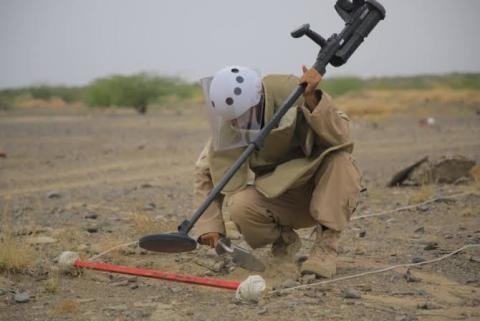Humanitarian Biometrics in Yemen: The complex politics of humanitarian technology


The introduction of biometrics in Yemen is a prime example of challenges related to the use of biometric solutions in humanitarian contexts. The complexity of the situation in Yemen needs to be acknowledged by policy makers and other stakeholders involved in the humanitarian crisis unfolding in the country.
Yemen is experiencing a humanitarian catastrophe. Currently, a majority of Yemeni, more than 24 million people – 80 percent of the population – are in need of humanitarian assistance to cover their basic needs.
According to the UN, more than 16 million of those face crises levels of food insecurity and, of those, 3.5 million women and children require acute treatment for malnutrition. A child dies every 10 minutes from diseases, such as measles and diphtheria, that could easily be prevented, leading UN Secretary-General António Guterres to describe childhood in Yemen as a special kind of hell.
This humanitarian catastrophe is man-made. The truism that reality is complex should not be used to detract from this simple but unpleasant fact. The catastrophe in Yemen has developed to its current unfathomable level because of choices that have allowed it to continue and deteriorate. Some of these have been deliberate whereas others have been accidental or the result of decisions with seemingly unintended side effects.
Cutting aid is a death sentence
The international community has struggled to find effective strategies for alleviating the suffering of ordinary Yemeni. Simultaneously, belligerents on the ground repeatedly demonstrate blatant disregard for the lives of the people they purport to defend and represent.
The lack of trustworthy data and the absence of simple solutions can lead to resignation. The most recent UN donor conference had an aid goal of $3.85 billion but only $1.7 billion was pledged, meaning that as of April 2021 aid agencies are only reaching half of the 16 million people targeted for food assistance every month. Clearly, a lack of engagement with Yemen has direct implications for the thousands of men, women and children that suffer the consequences of this conflict every day.
Challenging context for humanitarian work
Humanitarian aid agencies point to Yemen as a complex and challenging context for humanitarian work. They face bureaucratic and political obstacles and restrictions on movement that limit access to beneficiaries, as well as difficulties in reaching parts of Yemen due to the dispersion of settlements, and weak infrastructure that has deteriorated further during the conflict.
Further, the highly unstable security situation impedes effective humanitarian assistance delivery. Finally, there is a lack of reliable data, making it difficult for aid agencies to properly track and document both needs and effects of aid. This is only exacerbated by the conflicting parties lack of transparency and accountability. In Yemen, humanitarian aid is big business.
Biometric-based humanitarian responses
As explored in the policy brief Piloting Humanitarian Biometrics in Yemen: Aid Transparency versus Violation of Privacy?, the World Food Programme (WFP) has developed a digital assistance platform, SCOPE, to manage the registration of and provision of humanitarian assistance and entitlements for over 50 million beneficiaries worldwide.
According to the UN, more than 16 million of those face crises levels of food insecurity and, of those, 3.5 million women and children require acute treatment for malnutrition. A child dies every 10 minutes from diseases, such as measles and diphtheria, that could easily be prevented, leading UN Secretary-General António Guterres to describe childhood in Yemen as a special kind of hell.
This humanitarian catastrophe is man-made. The truism that reality is complex should not be used to detract from this simple but unpleasant fact. The catastrophe in Yemen has developed to its current unfathomable level because of choices that have allowed it to continue and deteriorate. Some of these have been deliberate whereas others have been accidental or the result of decisions with seemingly unintended side effects.
Cutting aid is a death sentence
The international community has struggled to find effective strategies for alleviating the suffering of ordinary Yemeni. Simultaneously, belligerents on the ground repeatedly demonstrate blatant disregard for the lives of the people they purport to defend and represent.
The lack of trustworthy data and the absence of simple solutions can lead to resignation. The most recent UN donor conference had an aid goal of $3.85 billion but only $1.7 billion was pledged, meaning that as of April 2021 aid agencies are only reaching half of the 16 million people targeted for food assistance every month. Clearly, a lack of engagement with Yemen has direct implications for the thousands of men, women and children that suffer the consequences of this conflict every day.

Yemeni officials on Monday condemned arrests and prosecutions by the Iran-backed Houthi militia directed against media, journalists and celebrities…

Yemen's warring parties are gearing up for new waves of conflict in 2023 amid a lack of decisive steps towards sustainable peace, adding to the suf…

The UAE will help to recruit doctors and deliver crucial supplies for hospitals in Yemen under a major healthcare drive. The Khalifa bin…